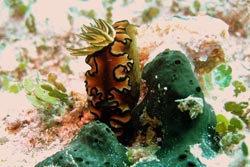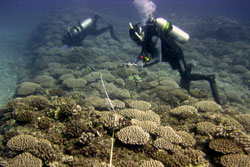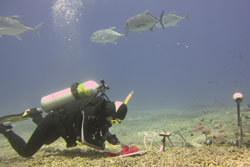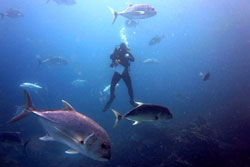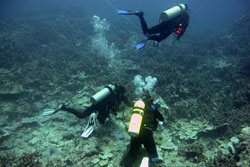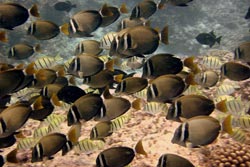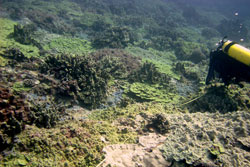
Papahānaumokuākea Marine National Monument Reef Assessment and Monitoring Cruise July 23 – August 21, 2011
Papahānaumokuākea Marine National Monument (PMNM) conducted the 2011 Reef Assessment and Monitoring Program (RAMP) research cruise to the Northwestern Hawaiian Islands (NWHI) from July 23 to August 21 aboard the NOAA ship Hiʻialakai. The islands visited were: Nihoa Island, Necker Island (Mokumanamana), French Frigate Shoals, Gardner Pinnacles, Maro Reef, Laysan Island, Lisianski Island, Pearl and Hermes Reef and Midway Atoll.
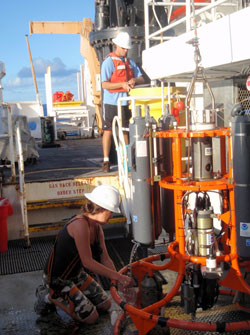
HPU scientists preparing for the deployment of the CTD at Mokumanamana. The objective of this project was to measure and characterize the carbon system in the coastal waters of the Monument to establish a baseline against which future environmental change can be detected and measured. The CTD was used to continuously record oxygen, temperature, pH and salinity data, while Niskin bottles were triggered at discrete depths for water sample collection. In the ship’s wet lab, shipboard measurements of dissolved oxygen and pH were performed immediately after each cast for instrument calibration and future comparisons against post-cruise analytical measurements. Photo by S. Godwin
The expedition supported SCUBA diver rapid ecological assessments (REAs) of reef fish, corals, other invertebrates, and algae; surveys of coral bleaching and disease; retrieval of deep water Ecological Acoustic Recorders (EAR) through the activation of acoustic releases; SCUBA diver sampling and research activities to assess bioerosion by marine organisms, disease and parasite prevalence within coral reef organisms and microbial source tracking; and shipboard operations for water sampling using a Conductivity, Temperature, and Depth (CTD) array focused on the carbonate chemistry of coral reef habitats. The scientific party consisted of personnel from NOAA: National Marine Sanctuary Program (NMSP), National Marine Fisheries Service (NMFS) Pacific Islands Fisheries Science Center (PIFSC) - Coral Reef Ecosystem Division (CRED), University of Hawaii faculty and students from Leeward Community College campus (LCC), Hawaii Institute of Marine Biology (HIMB), and the Hilo campus; and Hawaii Pacific University (HPU), Bernice Pauahi Bishop Museum (BPBM), State of Hawaii Department of Land and Natural Resources (DLNR-DAR) and Victoria University of Wellington, New Zealand (VUW).
Reef Assessment and Monitoring Program (RAMP)
As part of mandates from the Coral Reef Conservation Act of 2000, efforts to create structured monitoring began in the NWHI through the initiation of the RAMP. Since 2000, NOAA-PIFSC/CRED and the PMNM have conducted annual RAMP cruises to the NWHI with partners from the State of Hawaii, US Fish and Wildlife Service and a variety of academic institutions, with leadership alternating between PIFSC/CRED and PMNM since 2002.

